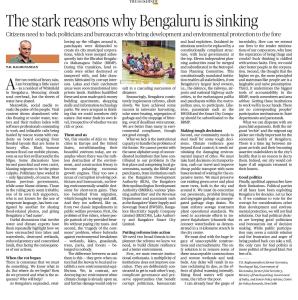10 Sep 2022 Editorial: The stark reasons why Bengaluru is sinking.

News Editorial : The stark reasons why Bengaluru is sinking.
GS Paper 1: Urbanization, their problems and their remedies.
Reasons for flooding in Bengaluru:
- Deterioration of rainwater infiltration due to growth of urban jungle: Ponnaiyar river catchment area of Bengaluru witnessed most of the flooding due to highly clayey soil and due to this only 3% of the water gets infiltrated in this soil condition.
- Irrational urbanisation in areas around various lakes in Bengaluru has resulted in the deterioration of original storm water drains.
- During transition from villages and panchayats into the Bhruhat Bengaluru Mahanagara Palike (BBMP) fake documents of land records were fabricated for corrupt interests.
- Due to the above corruption Lakes and their catchment areas were transformed into private lands.
- Builders backfilled these private lands and soon made quick money building apartments, shopping malls and information-technology parks.
- To become pulsating economic growth engines Bengaluru saw ruthless destruction of the environment.
- Bengaluru witnessed a nexus of corruption involving politicians and bureaucrats, abstaining from environmentally sensible decisions for short-term gains.
Way Forward:
- Building institutional capacity to handle the problems of the future through constitutionally compliant structure, with local governments at the top.
- Meeting the water requirement of Bengaluru by enhancing the recharge capabilities of the catchment by maintaining sufficient open spaces and green spaces with native species, decentralised rainwater harvesting, and wastewater treatment and reuse.
- Ecological imbalance leading to drying up of Arkavathy river due to check dams,excessive groundwater use and presence of eucalyptus plantations.
- Implementation of Innovative (ecological and engineering) solutions for water retention like watershed interventions in the Arkavathy basin by volunteers of agencies.
- Properly implementing reforms like rainwater harvesting, solar water heating, segregation of garbage and the stoppage of littering within the deadlines.
- Better Inter-agency Coordination: Instead of multiplicity of institutions there must be single institutions by merging and subordinating Eleven independent planning authorities to the Metropolitan Planning Committee for proper execution.
- Remove unacceptable constructions and restore wetlands and tank beds.
- Focus on Climate resilience that goes beyond flood control to minimise the damaging environmental impact on cities.
- Focus should be on improving cheap public transportation buses instead of waiting for the expensive metro.
- Preserve existing green cover and plant more trees, both in the city and around it.
- De-concretise pavements of Bengaluru prohibit littering and segregate garbage as unsegregated garbage clogs drains.
- Enforce sewage treatment plant operational standards.
- Efforts must be made to improve Rajakaluves (channels that connect water bodies).
- Make way for peoples’ participation in State departments and parastatals.
- Proper Accountability: In case of poor infrastructure design,make the whole chain of decision-making accountable.
Sources: The Hindu
Source links:
1.https://www.thehindu.com/opinion/lead/the-stark-reasons-why-bengaluru-is-sinking/article65871955.ece
2.https://www.thehindu.com/news/cities/bangalore/when-the-it-capital-went-under/article65872101.ece
Yojna IAS Daily current affairs eng med 10th Sep


No Comments